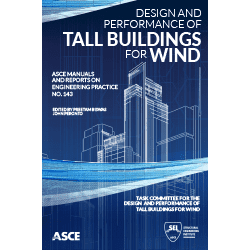Framework to Design Tall Buildings for Wind Offered in Newest ASCE Manual of Practice 143

Reston, Va. – ASCE’s new book, Design and Performance of Tall Buildings for Wind, MOP 143, provides a framework for the design of tall buildings for wind, based on the current state-of-practice in tall building structural design and wind tunnel testing. Design practices have varied across the industry without specific guidance for especially tall and slender buildings. This new manual presents detailed guidance on industry standard practices and design approaches that complement current literature, model codes, and standards.
The performance of tall buildings in wind depends on a combination of wind climate, loading effects, structural system, and damping. MOP 143 provides recommendations on setting and achieving performance objectives, including
- Selection of the wind loading mean recurrence interval (MRI) for serviceability;
- Establishment of performance objectives and acceptance criteria;
- Guidance on modeling building structural properties such as stiffness and damping; and
- Modeling of uncertainties in wind climate, wind loading, and other effects.
MOP 143 will be valuable resource for structural engineers, wind engineering consultants, architects, and other stakeholders with a vested interest in design of tall buildings.
To purchase online visit the ASCE Bookstore
Limited review copies are available for book reviews. Please contact Kevin Higgins, [email protected]; phone 703-295-6266.
NEW SEI Standards Series: Participants will gain an understanding of the technical revisions and review a design example. Attendees are encouraged to join and participate in Live Q&A. Sessions are intended for structural engineers, students, and the entire project stakeholder team. REGISTER NOW at https://cutt.ly/9hQDTEo
About ASCE
Founded in 1852, the American Society of Civil Engineers represents more than 150,000 civil engineers worldwide and is America’s oldest national engineering society. ASCE works to raise awareness of the need to maintain and modernize the nation’s infrastructure using sustainable and resilient practices, advocates for increasing and optimizing investment in infrastructure, and improve engineering knowledge and competency.


